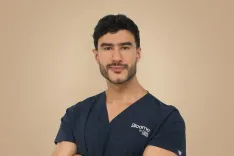Solution for a poor hyaluronic acid application
Aesthetic medicine can deliver spectacular results, but when hyaluronic acid is not applied correctly, the effects can be quite the opposite: lumps, asymmetry, inflammation, or product migration. If you relate to this situation, you are not alone. Fortunately, there are professional, safe, and effective solutions to reverse a poor application and restore the facial harmony you’re looking for.
What is a poor hyaluronic acid application?
- A poor application occurs when the product:Is injected into the wrong layer of the skin.Is over-applied.Is distributed unevenly or asymmetrically.Does not match the anatomy of the individual.
- This can be caused by:Lack of experience from the practitioner.Low-quality products.Incorrect techniques.
Result: Appearance of lumps, migration of the product (e.g., from the lip to the upper lip area), prolonged inflammation, facial stiffness, or an unnatural result.
Can a poorly applied hyaluronic acid treatment be corrected?
Yes. And the good news is that you don't have to live with an unsatisfactory result. Mistakes can be corrected and in many cases, the overall appearance of the face can even be improved.
Professional solution: hyaluronidase + a well-applied new treatment
The safest and most effective technique to reverse a poor application is the use of hyaluronidase, an enzyme that dissolves hyaluronic acid.
How does it work?
- Detailed facial assessment to identify product build-up or migration.
- Targeted application of hyaluronidase in specific areas. The product begins to act within minutes.
- Follow-up after a few days to ensure that all incorrectly placed filler has been eliminated.
- Reapplication with encapsulated hyaluronic acid, now done in a personalized and precise way using state-of-the-art technology.
Why choose encapsulated hyaluronic acid for correction?
After a bad experience, it’s essential that the new treatment is safer, more precise, and longer-lasting. Encapsulated hyaluronic acid meets all these criteria.
Benefits during correction:
- It is released in a controlled manner.
- Distributes more evenly.
- Reduces the risk of lumps or build-up.
- Delivers more natural-looking results.
- Ideal for sensitive skin following a poorly applied previous treatment.
Is it safe to dissolve hyaluronic acid?
Yes, as long as it’s done by an experienced professional. Hyaluronidase is approved and widely used in aesthetic medicine. However, a poor application of this enzyme can also lead to complications, which is why it’s crucial to go to a certified, reputable clinic.
When should hyaluronic acid not be reapplied?
- If there’s still inflammation or residual product from the previous treatment.
- If the recommended recovery time after hyaluronidase has not been respected.
- If there is no proper facial treatment plan tailored to the patient.
Faq
Does the correction treatment hurt?
It is usually well tolerated. Topical anesthesia can be applied if needed.
Does hyaluronidase remove all the product?
Yes, but it may require more than one session, depending on the amount of filler present.
After a bad experience, can I trust another treatment?
Yes. With the right professional and a proper approach, you can achieve beautiful and natural results.
Can I get other facial treatments afterward?
Yes, but it’s recommended to wait a few days or weeks, depending on the case.


